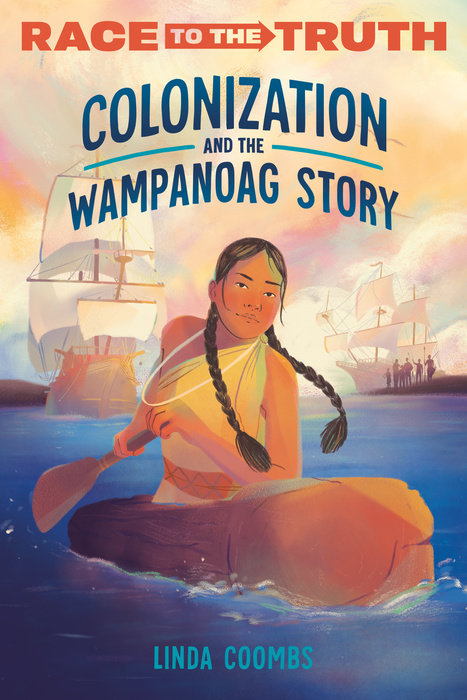Colonization and the Wampanoag Story
Author Linda Coombs
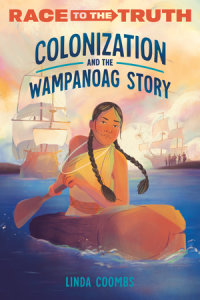
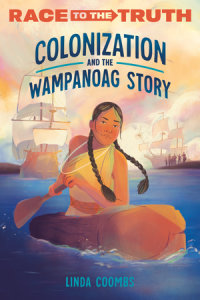
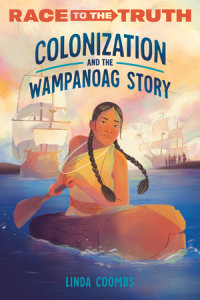
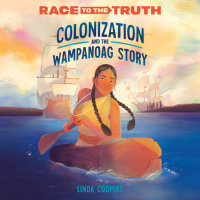
Colonization and the Wampanoag Story
Colonization and the Wampanoag Story is a part of the Race to the Truth collection.
Until now, you've only heard one side of the story: the "discovery" of America told by Christopher Columbus, the Pilgrims, and the Colonists. Here's the true story of America from the Indigenous perspective.
When you think about the beginning of the American story, what comes to mind? Three ships in 1492, or perhaps buckled hats and shoes stepping off of the Mayflower, ready to start a new country. But the truth is, Christopher Columbus, the Pilgrims, and the Colonists didn't arrive to a vast, empty land ready to be developed. They arrived to find people and communities living in harmony with the land they had inhabited for thousands of years, and they quickly disrupted everything they saw.
From its "discovery" by Europeans to the first Thanksgiving, the story of America's earliest days has been carefully misrepresented. Told from the perspective of the New England Indigenous Nations that these outsiders found when they arrived, this is the true story of how America as we know it today began.
An Excerpt fromColonization and the Wampanoag Story
Chapter 1
When Life Was Our Own: Spring and the Time of the New Year
Greeting the Day
Little Bird felt a slight breeze on her face and the sudden warmth of the morning sun, bidding her to open her eyes to a new day. Her body resisted rousing from the warm furs of the bed. Maybe just one more snuggle before getting up! Just yesterday, her family and many others had moved from the winter home to their summer cornfields. Sachem Corn Tassel, the leader of their village, had Little Bird’s family return to the same field they’d planted in last year.
Little Bird was twelve now, and had helped her Grandma Yellow Sky, Grandpa Singing Wolf, and Auntie Blue Heron carry all the bags and baskets that held everything to set up their summer household. There were dishes and cooking utensils; tools for tanning hides, woodworking, and stone knapping; axes and hoes for working in the garden; and bags of cordage (string and rope) used for making nets or weaving mats. It was…
Chapter 1
When Life Was Our Own: Spring and the Time of the New Year
Greeting the Day
Little Bird felt a slight breeze on her face and the sudden warmth of the morning sun, bidding her to open her eyes to a new day. Her body resisted rousing from the warm furs of the bed. Maybe just one more snuggle before getting up! Just yesterday, her family and many others had moved from the winter home to their summer cornfields. Sachem Corn Tassel, the leader of their village, had Little Bird’s family return to the same field they’d planted in last year.
Little Bird was twelve now, and had helped her Grandma Yellow Sky, Grandpa Singing Wolf, and Auntie Blue Heron carry all the bags and baskets that held everything to set up their summer household. There were dishes and cooking utensils; tools for tanning hides, woodworking, and stone knapping; axes and hoes for working in the garden; and bags of cordage (string and rope) used for making nets or weaving mats. It was only a mile’s walk from the winter village, but it all seemed to get heavier as Little Bird walked along. Her arms felt like she had carried ten bags instead of only four!
Little Bird finally got one eye open and saw her mom standing just outside the door. Smiling Dove was offering her morning prayers. Little Bird slid out from under the furs and quickly dressed. She went out and took Mom’s hand, joining her in giving thanks for another morning. Her dad was standing near the cornfield. Strong Bear faced east toward the ocean, his hand raised with his tobacco offering.
Little Bird looked across all the cornfields, which went as far as the eye could see. Everyone’s houses were in the middle of the fields, where they could watch over their crops. People were coming out of their houses, offering prayers and getting fires started. Little Bird loved this first part of the morning. It was quiet and peaceful, and you could collect your thoughts for the day. The smell of salt air was gently pungent, with only birdsong accenting the tranquility.
Back toward the winter village, the forest met the edges of the cornfields. The pine trees whispered their greetings as the wind rustled through their thick branches. Little Bird loved the sound of the wind rustling through the pines. She took a moment to just stand and listen.
Summer Move
Mom and Dad had come a few days earlier to check the frame of the house and make any necessary repairs. They had brought the bulrush and cattail mats that covered the frame so the rest of the family would have a roof over their heads when they arrived. Smiling Dove’s field was close to a stream, at a place where the water tumbled down over the rocks like a tiny waterfall. A little pool formed at the bottom of the rocks, and sometimes you could find a bass or perch or trout resting from his travels. It was in a shady spot, deep enough to sit in on a hot sunny day, to splash around and wash the dust off from working in the garden. Last summer, when Strawberry, Little Bird’s little sister, stood in the pool, the water came up to her neck. This year she was six, and so much taller, she figured the water would only be up to her chest!
Every day more people arrived, setting up and settling in for the summer. There was always so much to do! Some house frames needed repair; some needed to be replaced altogether. Smiling Dove’s house was in good shape and didn’t need a lot of work. The fields needed to be burned over and the soil turned. There were herring to be caught, Planting Ceremonies to hold, and corn to set in the earth. When all these things were done, it was time for the New Year Ceremonies, on the new moon in the Sowing Month When Corn Is Planted.
Time to Eat!
After morning prayers, Smiling Dove went back to their storage pit and brought out the rest of the dried food left from last fall. There was still a huge basket of corn for eating, as well as the seed corn. Little Bird and Strawberry helped carry bags of dried beans, making two more trips to get all the baskets of dried squash and pumpkin, sunflower seeds, blueberries, and cranberries. There was even a small basket of smoked deer meat--maybe enough for a few meals.
Mom took everything into the house. She was going to cook inside today, as there was still an edge on the wind. Besides, the arbor over the summer kitchen just outside still needed new sheets of bark on its roof. The old ones were brittle and breaking, their edges curling up. Smiling Dove stirred the embers of the fire back together, added some kindling, and got a good blaze going again. She took a medium-size clay kettle, filled it half full of water, and set it on three stones next to the main fire. Putting two handfuls of dried corn into the mortar, she began to crack it with the stone pestle.
Strawberry wanted to help so Mom showed her how to pick the heavy pestle up and drop it on the kernels to break them down into meal. Strawberry had to use both hands to hold the pestle even though it only had to be lifted a little ways. The mortar was deep enough to keep the corn from bouncing out when the pestle hit it. A very determined and zealous Strawberry, however, lifted the pestle too high, so when it dropped on the corn, kernels flew out, landing on the ground. Smiling Dove and Little Bird knelt and began picking them up. Neither had to say a word to Strawberry. She also started picking up the corn, realizing her mistake. She remembered the times when Grandma, Mom, Blue Heron, and others talked about corn and all food coming from living beings, how corn was a sacred plant to be handled with respect. The flyaway kernels were rinsed off and dried, to be used another day.
Meanwhile, Mom asked Little Bird to start a fire under the kettle, between its tripod of three rocks. The sticks and twigs burned into coals in just a few minutes. Little Bird kept feeding the fire, and very soon bubbles began to form on the water. Mom put three handfuls of Strawberry’s cracked corn into the pot.
She asked Little Bird to fill another kettle with more water at the spring. It was not far from the house, rippling out of the bank of the stream. By the time she got back, the corn was boiling steadily, and Mom had added some dried beans. She tamped the fire down a bit, so the pot would simmer. Strong Bear had made her a new stirring paddle of maple wood, carving a dove at the end of the handle. The girls could see how pleased Mom was with the paddle as she stirred the food, making sure nothing was sticking to the bottom of the kettle.
Strawberry had used all the strength in her arms to over-heft the pestle during her corn-pounding lesson. She leaned back on the bed to rest--her arms felt the way mud pies look when you make them in the rain. She closely watched Smiling Dove, who was grinding more kernels in the mortar. Strawberry realized that Mom really didn’t put much effort into cracking the corn. She lifted the pestle and let it drop. Lift and drop, lift and drop. She let the pestle do the work.
Little Bird didn’t think she’d ever been hungrier and couldn’t wait to eat! They’d had a big supper when they got to the fields, which clearly wasn’t enough to hold her until breakfast.
She helped Mom mix the cornmeal with hot water and dried blueberries, making dough for boiled bread. They formed the dough into little round cakes and dropped them into the simmering pot of stew when it was just about done.
Finally! The food was ready! Little Bird waited patiently, helping Mom serve bowls of stew and boiled bread to Grandma and Grandpa and to her dad. Then Mom gave Little Bird and Strawberry their breakfast, before making a dish for herself. No one started eating until a prayer of thanks was given, to the corn, the beans, the water, the blueberries--everything that made the stew hot and satisfying on a cool spring morning.
Into the Cedar Swamp
After breakfast, Strong Bear and his brother Tall Pine met with a group of the men. They were deciding who would go into the cedar swamp to gather saplings for the house frames that needed repair, and who would begin burning over the cornfields, getting them ready for planting.
Strong Bear went with the men to the swamp. This particular swamp extended over such a huge area that people from several villages harvested from it.
The people had built their homes of cedar poles for centuries, knowing that the time to harvest was in the spring when the sap rose in the trees. This was what allowed the poles to be bent into the house frames without breaking. Upon entering the swamp, the men chose the area to begin cutting.
First and foremost, they offered prayers, thanking the trees for the gift of their lives so the people could build homes. They also showed respect by cutting in a way that encouraged the growth of new saplings. The men tended the areas they cut so that conditions in the swamp were ideal for the trees to flourish. Swamp cedar grows tall and straight, with most branches near the tops of the trees. The limbs and seed cones were trimmed off and left to produce new saplings.
The cut poles could be thirty feet long, or more. When the men brought them back to the planting sites, they were put in the river to keep them supple and bendable. The first job was to peel the bark off, and everyone, even some of the little kids, pitched in to help. This kept bugs from burrowing into the frames of the houses, and the bark itself had many uses. The outer bark was separated from the smooth inner layer and used as tinder to start fires. The inner bark became lashing for the house frames, mats for the floors, and also, baskets.
A complete, brand-new frame could be built in a day, although Smiling Dove’s house only needed new lashings in some spots to hold the frame together. The house really didn’t need much work after the winter.
No parts of the trees were ever wasted. Cedar, like tobacco, is a sacred plant, and the leaves were used in ceremony.
Burning the Fields
Tall Pine and his family lived near Strong Bear, in the next cornfield over. He met with some of the other men to begin the plan for burning and clearing the fields, including those that would lie fallow and not be planted this year. This was done in spring and fall. The ashes were worked back into the mounds, enriching the soil to help the corn and other vegetables grow. When ready for planting, the fields looked like a grid of foot-high hills spaced evenly apart, stretching as far as the eye could see.
This was such a good time of year! Each family had a large planting field, about an acre or more for their corn. Men, women, and children worked together on the gardens, sometimes singing, always laughing. The women cooked lots of food, and everyone would take a break and sit in the shade to have a meal. People always carried their own bowl and spoon for just such occasions. Cleanup for a hundred people was easy, as everyone washed their own dishes after they ate!
Herring Peepers, Herring Time
Everyone checked the river every day, watching for the herring to come up on their spawning runs. The people used them for food and also for fertilizer in the gardens. The herring peepers, little frogs who emerge from their muddy winter hibernation in early, early spring, had been heard for weeks now. Little Bird and her dad spent many evenings sitting quietly and listening to the comforting rhythm of their chirping chorus, carrying the promise of spring.
Strawberry could never figure out how the herring knew which river to follow to come back up to the pond they were born in. Little Bird explained this to her every year, but so far it was still a big mystery! Maybe this was the year that she would come to this understanding. Everyone learns in their own time. Little Bird noticed, however, that Strawberry had no trouble understanding when the herring were roasted and juicy over the fire! She was already adept at removing the many bones so she didn’t choke as she swallowed tender morsels of her fish dinner. She wanted to be just like her Dad and her Grandpas, who could eat and maneuver the bones out the sides of their mouths into a wondrous, woven net-looking . . . thing!
The herring being so bony was the reason they made good fertilizer for the corn mounds. When they were running heavily, the men would collect them with dip nets, and carry basketfuls to the cornfields. Of course, this was always done with proper ceremony, acknowledging the fish that were giving up their lives, so everyone could grow their corn. Fertilizing was not done every year, but only when the soil needed it. Otherwise, only enough herring for food was caught.
The men worked very hard with the river. They cleared fallen branches from certain places so the water could flow freely, but they left brush in other places so the fish could rest there, hidden from hawk-view.
The men also helped in the gardens, digging holes for the fish fertilizer with stone-bladed hoes, then hilling the earth into mounds. Smiling Dove’s fields didn’t need fertilizer this year, and Little Bird and Strawberry didn’t mind not having to handle the slippery fish! Putting two fish in each hole in the entire garden took hundreds of fish. That was a lot of slipperiness to then hill the mounds up over! Actually, Little Bird didn’t even mind this work. Preparing the garden was very pleasant in the spring sunshine and gentle breezes. She loved the feeling of working with her hands in the warm earth--like being home, connected, knowing you’re exactly where you’re supposed to be.
Corn Mother: Planting Time
Smiling Dove, along with Little Bird and Strawberry, met with the women from all the other families. The clan mothers gathered them together to organize the Spring Planting Ceremonies. The women’s connection to the corn was honored, as both are female spirits. The corn, beans, squashes, pumpkins, melons, and sunflowers are acknowledged and given thanks for the food and nourishment that they provide. Their lives make it possible for ours to continue.
